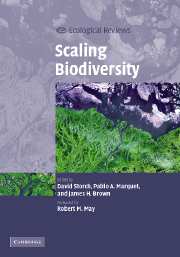Book contents
- Frontmatter
- Contents
- List of contributors
- Foreword by Robert M. May (Lord May of Oxford)
- Preface
- 1 Introduction: scaling biodiversity – what is the problem?
- PART I Spatial scaling of species richness and distribution
- PART II Alternative measures of biodiversity: taxonomy, phylogeny, and turnover
- PART III Scaling of biological diversity with energy and the latitudinal biodiversity gradient
- PART IV Processes, perspectives, and syntheses
- 16 Spatiotemporal scaling of species richness: patterns, processes, and implications
- 17 Scaling biodiversity under neutrality
- 18 General patterns in plant invasions: a family of quasi-neutral models
- 19 Extinction and population scaling
- 20 Survival of species in patchy landscapes: percolation in space and time
- 21 Biodiversity power laws
- Index
- Plate section
- References
19 - Extinction and population scaling
Published online by Cambridge University Press: 05 August 2012
- Frontmatter
- Contents
- List of contributors
- Foreword by Robert M. May (Lord May of Oxford)
- Preface
- 1 Introduction: scaling biodiversity – what is the problem?
- PART I Spatial scaling of species richness and distribution
- PART II Alternative measures of biodiversity: taxonomy, phylogeny, and turnover
- PART III Scaling of biological diversity with energy and the latitudinal biodiversity gradient
- PART IV Processes, perspectives, and syntheses
- 16 Spatiotemporal scaling of species richness: patterns, processes, and implications
- 17 Scaling biodiversity under neutrality
- 18 General patterns in plant invasions: a family of quasi-neutral models
- 19 Extinction and population scaling
- 20 Survival of species in patchy landscapes: percolation in space and time
- 21 Biodiversity power laws
- Index
- Plate section
- References
Summary
Introduction
Arguably, the most important development in ecology in the past few decades has been the discovery of space. The spatial structure of populations and their interactions has become increasingly central to our understanding of ecological dynamics, revolutionizing many areas of both theory and application (e.g. Tilman & Kareiva, 1997). While this is true of all organisms, spatial aspects of population biology are particularly apparent in sessile organisms such as plants. Plant populations are spatially complex, with individuals typically clustered within patches that are themselves aggregated in habitats that are patchily distributed in space. Despite attempts to define the “natural” scale of patchiness (reviewed in Dale, 1999), most populations I know of appear aggregated at virtually any spatial scale. This greatly complicates the description of the abundance and distribution of species, as most of the useful measures are intrinsically scale bound. Indeed, many different aspects of abundance can be reflected by grid occupancy at some appropriate scale of resolution (Kunin, 1998). Thus the extent of a species' geographic range reflects its coarse-scale distribution, whereas population size or cover reflects fine-scale abundance, with factors such as the number of discrete subpopulations or habitat specialization being reflected at intermediate scales.
In an attempt to summarize such spatially complex patterns, the area occupied by a species may be plotted at multiple spatial scales on logarithmic axes, into a “scale area curve” that could summarize abundance scaling.
- Type
- Chapter
- Information
- Scaling Biodiversity , pp. 396 - 408Publisher: Cambridge University PressPrint publication year: 2007



